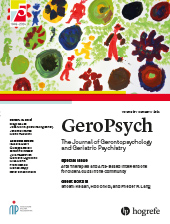Psychologische Aspekte der Rehabilitation älterer Menschen: Befunde einer empirischen Studie
Psychological Aspects of Rehabilitation in Old Age: Findings from an Empirical Study
Abstract
Zusammenfassung: Psychologische Variablen werden allgemein als bedeutsam für den Verlauf und Ausgang geriatrischer Rehabilitation angesehen, jedoch liegen nur wenige empirische Studien zu dieser Thematik vor. In der vorliegenden Arbeit wurden N = 90 ältere Menschen (M = 78.8; 84 % Frauen) vor und nach Ende einer geriatrischen Rehabilitation mit einem Instrumentarium untersucht, das sowohl im engeren Sinne “geriatrische” Verfahren (wie Barthel-Index) wie auch psychologische Maße beinhaltete. Ein besonderes Auswertungsanliegen war die Untersuchung der Frage, ob sich das korrelative Gefüge der Variablen vor und nach der Rehabilitation bedeutsam unterscheidet. Hier zeigte sich, dass dieses vor allem im Kontext der Variable Autonomie, jedoch nicht hinsichtlich des subjektiven Wohlbefindens der Fall war. So ko-variierten nach Abschluss der Rehabilitationn psychologische Maße wie z. B. Ängstlichkeit und verhaltensbezogene Bewältigung stärker mit der Variable Autonomie als vor Beginn der Rehabilitation. Eine Erklärung hierfür könnte darin liegen, dass psychische Variablen (wieder) eine größere Rolle für die Aufrechterhaltung von Autonomie spielen, wenn gegen Ende der Rehabilitation die physischen Potenziale reaktiviert sind.
Summary: Psychological variables play a prominent role when it comes to the course and outcome of geriatric rehabilitation, but empirical research is rare in this regard. In the present work, N = 90 older adults (M = 78.8; 84 % women) were assessed before and after a geriatric rehabilitation treatment based on more “geriatric” (e. g., Barthel index) as well as psychological measures. Special attention was given to the question whether meaningful pre-post changes in co-variance structures could be observed. Findings support the notion that this was the case with respect to autonomy and not so much regarding subjective well-being. In particular, measures of anxiety and behavioral-focused coping co-varied clearly stronger with autonomy after the rehabilitation. One explanation for this may be that psychological variables gain (again) a more stronger role in autonomy maintaining processes, when physical potentials have been re-activated at the end of the rehabilitation.
Literatur
(1992). The dependency-support script in institutions: Generalization to community settings.. Psychology and Aging, 7, 409– 418
(1990). Entwicklungspsychologie der Lebensspanne: Theoretische Leitsätze.. Psychologische Rundschau, 41, 1– 24
(1998). Lifespan theory in developmental psychology.. In R.M. Lerner (Ed.), Handbook of child psychology (5th ed., Vol. 1, S. 1029-1143). New York: Wiley.
(1975). “Mini Mental State” A practical method of grading the cognitive state of patients for the clinician.. Journal of Psychiatric Research, 12, 189– 198
(1993). Impact of social support on outcome in first stroke.. Stroke, 24, 64– 70
(1982). The assessment of aphasia and related disorders. . Philadelphia: Lea & Febiger.
(1997). Geriatric rehabilitation: State of the art.. Journal of the American Geriatrics Society, 45, 1371– 1381
(1993). Trierer Skalen zur Erfassung der Krankheitsbewältigung (TSK). . Göttingen: Hogrefe.
(1992). Rehabilitation in der Gerontologie - theoretische Grundlagen und empirische Forschungsergebnisse.. In A. Mühlum & H. Oppl (Hrsg.), Handbuch der Rehabilitation (S. 333-355). Neuwied: Luchterhand.
(1981). Das State-Trait-Angstinventar (STAI). Theoretische Grundlagen und Handanweisung. . Weinheim: Beltz.
(1975). The Philadelphia Geriatric Center Morale Scale: A revision.. Journal of Gerontology, 30, 85– 89
(1965). Functional evaluation: The Barthel index.. Maryland State Medical Journal, 14, 61– 65
(2000). Erfolg und Erfolgsvariabilität der stationären Rehabilitation alter Menschen: Eine empirische Studie auf der Basis medizinisch-geriatrischer und psychosozialer Indikatoren.. Zeitschrift für Gerontologie und Geriatrie, 33, 24– 35
(1998 Februar). Bedeutung von medizinisch-geriatrischen und psychologischen Variablen für den Erfolg stationärer Rehabilitation älterer Menschen. . Forschungsbericht aus dem DZFA Nr. 3.
(1998). Intervention research with older adults: Introduction, overview, and future directions.. In R. Schulz, G. Maddox & M.P. Lawton (Eds.), Focus on interventions research with older adults. Annual Review of Gerontology and Geriatrics (Bd. 18, S. 1-16). New York: Springer.
(1993). Psychosocial and behavioral dimensions of physical frailty.. The Journals of Gerontology, 48(Special Issue), 39– 43
(1996). Alter aus psychologischer Perspektive: Trends und Profile im hohen Alter.. In K.U. Mayer & P.B. Baltes (Hrsg.), Die Berliner Altersstudie (S. 221-250). Berlin: Akademie-Verlag.
(1987). Social networks as assets and liabilities in recovery from stroke by geriatric patients.. Psychology and Aging, 2(2), 125– 129
(1998). Rehabilitation in old age: Psychosocial issues.. In A. Hersen & M. Bellach (Eds.), Comprehensive clinical psychology (Bd. 7, S. 525-550). Oxford, England: Elsevier.
(1986). Performance-oriented assessment of mobility problems in elderly patients.. Journal of the American Geriatrics Society, 34, 119– 126
(1998). Kompetenz und Unselbständigkeit im höheren Lebensalter: Erkenntnisse der neueren gerontologischen Grundlagenforschung.. In U. Havemann-Reinecke, S. Weyerer & R. Fleischmann (Hrsg.), Alkohol und Medikamente. Missbrauch und Abhängigkeit im Alter (S. 9-28). Freiburg: Lambertus.
(2001). Predictors of well-being and autonomy before and after geriatric rehabilitation.. Journal of Health Psychology, 6(3), 331– 346
(1975). Path models with latent variables: The NIPALS approach.. In H. Blelock (Ed.), Quantitative sociology: International perspectives on mathematical and statistical model building (S. 307-357). New York: Academic Press.


